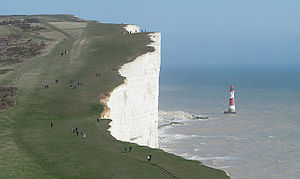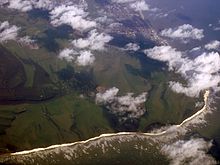Beachy Head

Beachy Head is a chalk headland on the south coast of England, close to the town of Eastbourne in the county of East Sussex, immediately east of the Seven Sisters. The cliff there is the highest chalk sea cliff in Britain, rising to 162 m (530 ft) above sea level. The peak allows views of the south east coast from Dungeness to the east, to Selsey Bill in the west. Its height has also made it one of the most notorious suicide spots in the world.[1]
Geology

The chalk was formed in the Late Cretaceous period, between 65 and 100 million years ago, when the area was under the sea. During the Cenozoic Era the chalk was uplifted (see Cenozoic Era). When the last Ice Age ended, sea levels rose and the English Channel formed, cutting into the chalk to form the dramatic cliffs along the Sussex coast.
Wave action contributes towards the erosion of cliffs around Beachy Head, which experience frequent small rock falls. Since chalk forms in layers separated by contiguous bands of flints, the physical structure affects how the cliffs erode. Wave action undermines the lower cliffs, causing frequent slab failures - slabs from layers of chalk break off, undermining the upper parts of the cliffs, which eventually collapse.[2] In contrast to small rock falls, mass movements are less common. A mass movement happened in 2001 when, after a winter of heavy rain, the water had began to seep into the cracks which had frozen and caused the cracks to widen. This then made the cliff edge erode and collapse into the sea.
History

The name Beachy Head appears as 'Beauchef' in 1274, and was 'Beaucheif' in 1317, becoming consistently Beachy Head by 1724, and has nothing to do with beach. Instead it is a corruption of the original French words meaning "beautiful headland".[3]
In 1929 Eastbourne bought 4,000 acres (16 km2) of land surrounding Beachy Head to save it from development at a cost of about £100,000.[4]
The prominence of Beachy Head has made it a landmark for sailors in the English Channel. It is noted as such in the sea shanty Spanish Ladies :
- "The first land we sighted was called the Dodman,
- Next Rame Head off Plymouth, off Portsmouth the Wight;
- We sailed by Beachy, by Fairlight and Dover,
- And then we bore up for the South Foreland light."
The ashes of German social scientist and philosopher Friedrich Engels, one of the fathers of communism were scattered off Beachy Head cliffs into the Channel, as he had requested.[3]
Lighthouses
The headland was a danger to shipping. In 1831 construction began on Belle Tout lighthouse on the next headland west from Beachy Head. It became operational in 1834.
Because mist and low clouds could hide the light of Belle Tout, another lighthouse was built in the sea below Beachy Head. It was 43 m in height and became operational in October 1902.[3] For more than 80 years, the red-and-white striped tower was manned by three lighthouse keepers. Their job was to maintain the light, which rotates two white flashes every 20 seconds and is visible 26 miles (42 km) out to sea. The lighthouse was fully automated in 1983.
Due to cliff erosion, in March 1999 Belle Tout lighthouse was moved more than 50 feet (15 m) further inland.[6]
Beachy Head at war
The third day of fighting in the Battle of Portland, 1653, took place off Beachy Head during the First Anglo-Dutch War. The Battle of Beachy Head, 1690, was a naval engagement during the Nine Years' War. During World War II, the RAF established a forward relay station at Beachy Head to improve radio communications with aircraft. In 1942, signals were picked up at Beachy Head which were identified as TV transmissions from the Eiffel Tower. The Germans had reactivated the pre-war TV transmitter and instituted a Franco-German service for military hospitals and VIPs in the Paris region. The RAF monitored these programmes hoping (in vain) to gather intelligence from newsreels.[7] There was also an important wartime radar station in the area and, during the Cold War, a radar control centre was operational in an underground bunker from 1953 to 1957.[3]
Tourism
West from Belle Tout, the cliffs drop down to Birling Gap, and beyond that the Seven Sisters. The area is a popular tourist attraction. Birling Gap has a restaurant and, in the summer, multiple ice cream vans serve the area.
Suicide spot

Since the 1600s, Beachy Head has been notorious as a location for people to attempt suicide, estimated at 20 each year.[8] The Beachy Head Chaplaincy Team conducts regular day and evening patrols of the area in attempts to locate and stop potential jumpers. There are also posted signs with the telephone number of The Samaritans urging potential jumpers to call them. Worldwide, the landmark’s notoriety for suicide is surpassed only by the Golden Gate Bridge in San Francisco and the Aokigahara Woods in Japan.[1]
After a steady increase in deaths between 2002 and 2005, in 2006 there were only seven fatalities, a marked decrease.[9] The Maritime and Coastguard Agency attributed the reduction to the work of the Chaplaincy Team and good coverage of services by local media.[9][10]
Use in film and television
The cliff was used in the opening sequence to the 1987 James Bond film The Living Daylights, in which Bond (played for the first time by Timothy Dalton) parachuted from a jeep which overshot the top of the cliff in a scene which was scripted as being in Gibraltar.[1]
Beachy Head was also the setting for The Cure's "Just Like Heaven" and "Close To Me" videos. [citation needed]
Documentary film
In 2001, Channel Four planned a series of programmes focusing on suicide, none of which was broadcast. The series included a film about Beachy Head, an hour-long documentary on the strange allure of this beauty spot by Roel van Broekhoven.[11]
In literature
The British Romantic poet Charlotte Turner Smith published a poem entitled "Beachy Head." This prospect poem places its reader at Beachy Head and uses its expansive view to discuss nature as well as political power and cultural dominance.[citation needed]
References
- ^ a b Meaney, Thomas. "Exiting Early: Is life worth living? The question is perennial. The answers include 'no'", The Wall Street Journal, April 15, 2006. Accessed November 14, 2009. "In a roundabout way of coming to terms with his death, Mr. Hunt made several trips to the cliffs of Beachy Head on the southern coast of England, which ranks as the third most popular suicide site in the world, after the Golden Gate Bridge and the Aokigahara Woods in Japan."
- ^ Beachy Head - Photographs and Geological commentary
- ^ a b c d Surtees, Dr John (1997). Beachy Head. Seaford: SB Publications. ISBN 1 85770 118 6.
- ^ Times, October 30, 1929. P. 11
- ^ Palmer, Roy (1986). The Oxford Book of Sea Songs. Oxford: Oxford University Press. ISBN 0192141597.
- ^ "The 28 ft (8.5 m) move that took a day". The Argus. 18 March 1999.
- ^ Ockenden, Michael (April 1983). "TV Pictures from Occupied Paris". After the Battle (39). Battle of Britain Prints International.
- ^ "Suicide jump child 'already dead'". BBC News Online. BBC. June 2, 2009. Retrieved 2009-06-02.
- ^ a b "Beachy Head suicide numbers down". BBC News Online. BBC. December 20, 2006. Retrieved 2009-06-02.
- ^ "Beachy Head Press Release". MCA Press Release. UK Maritime and Coastguard Agency. Retrieved 2009-06-02.
- ^ "Beachy Head" - Film by Roel van Broekhoven
External links
- Beachy Head, Eastbourne website
- Beachy Head walk to East Dean
- Beachy Head Chaplaincy Team
- Beachy Head Countryside Centre
- Online video of Broekhoven's film
- Landslides at Beachy Head British Geological Survey
